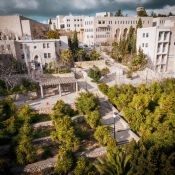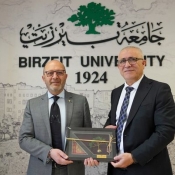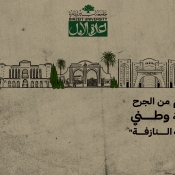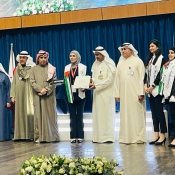Dr. Salim Tamari discusses the issue of Jerusalem, What about Jerusalem?
The following report is an edited version of a lecture that was given at Birzeit University as part of the program of Palestine and Arabic Studies by Dr. Salim Tamari on 22 July 1997. Dr. Tamari is a Professor of Sociology at Birzeit University specializing in Urban, Rural and Political Sociology and is currently the director of the Institute of Jerusalem Studies. The Palestine and Arabic Studies Program (PAS) is an academic program at Birzeit University that offers international students the opportunity to combine the study of the Arabic Language with social science courses about Palestine and the Arab World.
I have been asked to address the issue of the future of Jerusalem, which is one of the most tricky aspects of the final status negotiations in the Palestinian and Israeli negotiations. You probably know that in the Madrid peace conference of 1991, when the agreement at hand was made, a separation was made between the interim measures, which were finally negotiated in Oslo in the Declaration of Principles (DOP) and the two interim agreements, and final status issues, which the combined Israeli and Palestinian negotiators decided were not possible to resolve within the immediate interim measures. These were the issues of Jerusalem, refugees and settlements. There were other outstanding issues such as sovereignty, borders and currency, which were also long-term and left for final status, but in the DOP these were mentioned specifically in the light of the separation made in the Madrid Conference that the issue of Jerusalem would be negotiated at the end of the interim period, being May 1999, two years from now.
However, in a number of letters of assurances at the time from the American Foreign Minister and also later reiterated in a letter sent by Shimon Peres, the Israeli Prime Minister at the time, to Johan Jogan Holst, who was the Norwegian Foreign Minister, it was stated very clearly by the Israelis that while the interim period was going on, no changes on the ground would occur in Jerusalem which will preempt or prejudice the status of Jerusalem in the Final Status negotiations. That was taken to mean, although it was not enunciated in black and white and on paper, that the extension of settlements, the changes in laws of residency, changes in infrastructure, blockades of the city of Jerusalem from entrance to it by Palestinian residents, refugee reparations to Palestinians, and things like family reunification shall not be altered so that the Jewish population of the city would become more than the Arab population of the city. There was also an unwritten agreement, within the Israeli political circles, that a formula was established so that the demographic growth between the number of Jews and the number of Arabs would be maintained at the rate of 72 to 28.
I know that these sound like very bizarre statistics, but actually it has been linked, of course never officially declared, but often discussed openly by Israeli ministers, that the number of Jews to Arabs has remained 72 to 28. This was an unwritten demographic figure which the Israelis had in their minds, in which one third of the population would be Arab and two thirds would be Jewish and all attempts at inviting Jewish residents to come to Jerusalem would be the aim to counteract the heavy fertility rate of Arab populations. This was the demographic obsession, which is an obsession not only with the city of Jerusalem, but an obsession within the Zionist movement over the possibility of a sudden surge in the Arab population because of high fertility.
So all these combined factors created the recognition, partly psychological, partly implicit, but partly also enunciated in letters of assurances sent by the Americans, by Israeli Foreign ministry and in protocols made to the Palestinians in the course of the negotiations that nothing shall be made to preempt or prejudice the final status talks about Jerusalem.
At the heart of the current problem I believe, are these twin issues. The first one is that the assurances made about freezing the status of Jerusalem until 1999 was not abided to by the Israelis, and the second one that the Palestinians did not insist on strict detailed written assurances that their rights in the city shall not be violated while interim negotiations are in progress. These are the two main issues. The first one is a question of preemption and the second one is that the interim status of the city was lacking a base.
Why were these terms of assurances made to Johan Jogan Holst by Prime Minister Peres and by Foreign Secretary Schultz not abided to? First there was a question of settlements within Jerusalem. Not only the earlier ones like Rabot, maybe Ya’akov, and French Hill, which were being intensified, but also new ones that were being added after the peace agreements and building of existing settlements were proceeding at a very high rate and there were certain settlements, like Ma’ale Adumim, on the road to Jericho, which were now being relinked, or rather linked, to the outer rim of the eastern part of Jerusalem. So we have the question of settlements.
Second, since the peace agreements took place there has been a systematic exclusion of access to the city by Palestinians who wanted to work, shop, use the services of the city or even go to pray in the city. Access to the city since 1991 became increasingly more difficult and, after the assassination of Rabin, became almost impossible to residents of the West Bank and Gaza.
Thirdly, the possibility of residency in the city by Palestinians, which was relatively possible before the peace agreements, became almost impossible. A Palestinian today who marries a woman who is a resident of the city of Jerusalem with an Israeli ID, both of them being Arab, will not have the right to settle and live with his wife or her spouse. Rather, the spouse will be asked to move and settle with their spouse in the West Bank or Gaza. In other words there is only one way, relocation of residency.
Fourthly, many Palestinians who live inside the city and constitute the hundred and seventy thousand Palestinians living in the city, have been forced to live outside the city boundaries because of excessive amounts of municipal taxes imposed on them. This municipal tax is called arnona, which is a property tax, a residency tax, and is meant to deliver services by the Municipality to the residents whether they are Arabs or Jews. The difference of course is that in the Jewish part of the city there is a higher standard of living and therefore a higher standard of services. In the Arab part of the city, there is much more poverty, much more inability to pay these taxes and much lower services for the same dollar, or shekel, amount of taxes paid. This led to a substantial escape from the city by Arab residents who sought lower tax rates in Bethlehem, Jerusalem, A-Ram and other suburbs around Jerusalem which are not under Israeli law but are under the Israeli military administration or under Palestinian Authority rule.
In the last two years, Israel has begun to withdraw the residency permits of Palestinians who were Jerusalem residents but who no longer lived in the city because of this tax. This move was seen as a systematic attempt to phase out Jerusalem residency and, therefore, access to Jerusalem to a large number of the 170,000 Palestinian population.
Finally, because of these measures and others, there was a systematic push to relocate many Jewish suburbs from the Western part to the Eastern part of the city and to build new communities in order to bring about a belt of Jewish suburbs around the Arab cities around East Jerusalem, so that the Arab residents of the eastern part of the city would be sealed off and separated from the villages, townships and the Arab hinterlands of the city. There would be Jewish enclaves surrounding the city from all angles. The last of such angles was Har Homa, or Jebal Abu Ghneim, in which Netanyahu announced a few months ago that settlement building would begin in it to seal Jerusalem completely from all sides and therefore establish a Jewish encirclement of the city.
All of these moves did not bode well, one net effect of them being that for the first time today there are more Jews than Arabs in the Arab parts of the city. In other words, not only is there a 1 to 2 ratio between Arabs and Jews in the whole city, but there is now a majority of Jews in the Arab side of the city. At the rate of 51 to 49, or 52 to 48 percent Jews to Arabs. This demographic obsession of the Jewish numerical superiority and Israeli obsession of land laws, zoning laws, and municipal taxes, are contrived to exclude Arabs from the city and make sure that no access to the city from the West Bank and Gaza be made, was a bad omen for the beginning of final status talks and made many people wary, or weary, that by 1999 there would be very little left to negotiate in terms of the future.
Therefore, under the Netanyahu government, one of the most sticking points was not the issue of refugees, which was seen as possibly insoluble in stages, and not the issue of settlements, which were seen as colonial inclusions in the body of the West Bank and Gaza and could be demobilized, but the city of Jerusalem which is changing its demographic structures, changing its physical features, and changing its social fabric very rapidly in front of its own existing citizens and former citizens who no longer have access to the city. This is why there is so much hot debate about Jerusalem. Partly because it has so much emotional, sentimental, religious baggage that comes with it (there is so much sentimental attachment to it), and partly because Jerusalem is no longer a city that is familiar to its Arab residents and no longer accessible to its former Arab residents who cannot reach it anymore because of this sharp distinction between Israeli residency and West Bank or Gaza residents.
Now if this continues, if these trends proceed as they are, I think we will be faced with a very explosive situation pertaining to the future of the city itself. And one way to demystify this problem is to divide the issues surrounding the city of Jerusalem into three components: one is access, the second is control, and the third is sovereignty. Insisting on dealing with the city in these three dimensions in one package is emotionally satisfying and ideologically purist. But if we are going to negotiate an agreement which will allow us to disentangle the web of religious, ideological, and logistic attachment to the city from daily concern, from more practical considerations it might be useful to separate the issue of Jerusalem from the peace process.






